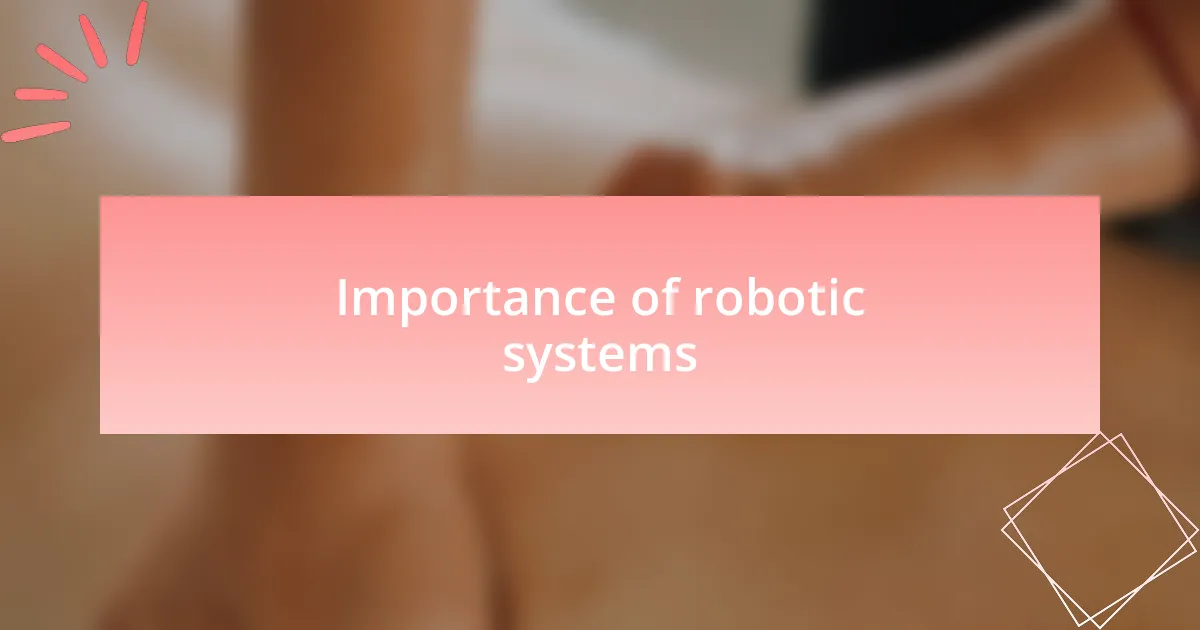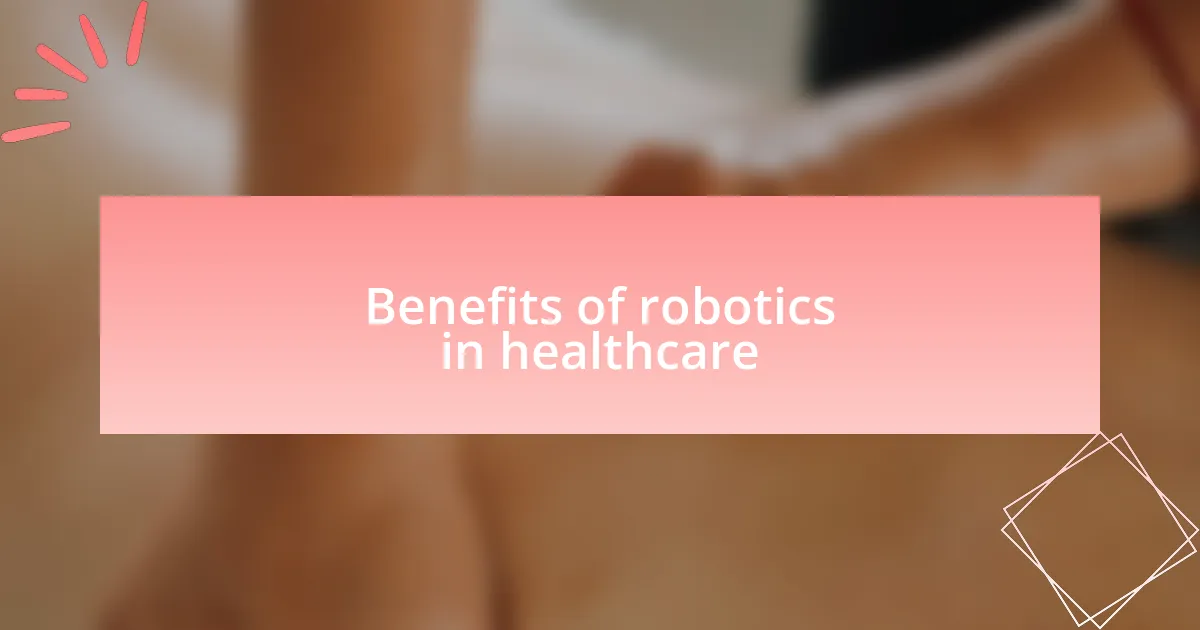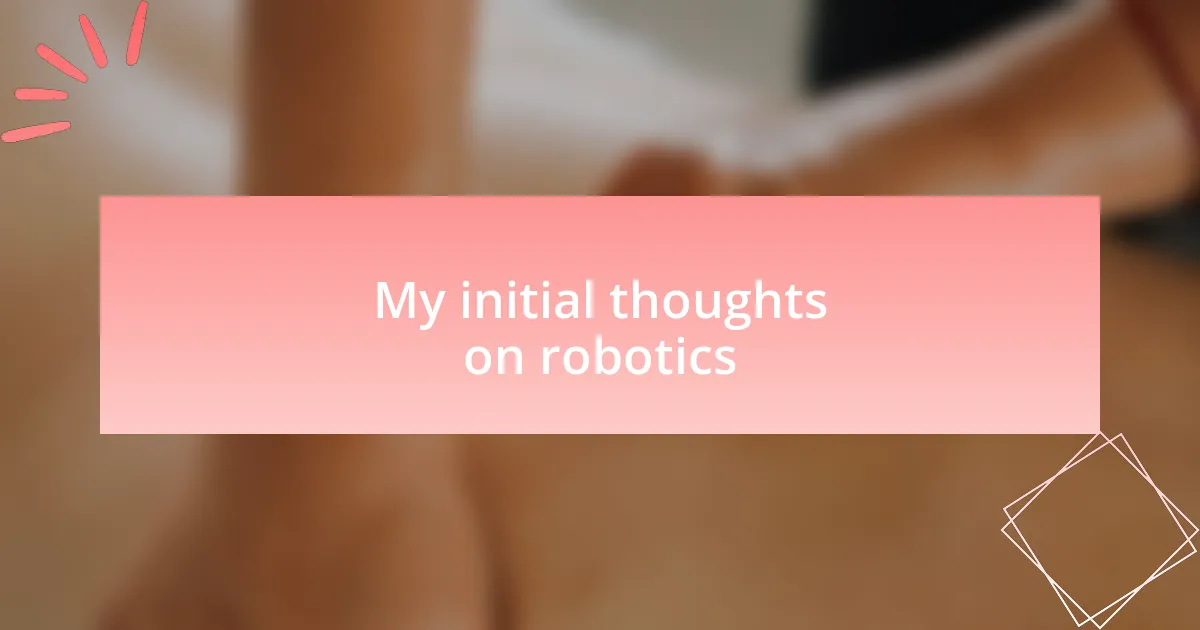Key takeaways:
- Healthcare innovation, exemplified by robotic systems, enhances patient outcomes through improved precision and reduced recovery times.
- Robotic systems bridge gaps in healthcare accessibility, allowing remote surgical assistance and improving patient care in underserved areas.
- Successful integration of robotics in healthcare requires open communication, tailored training, and a focus on maintaining empathy in patient interactions.
- The future of robotic healthcare holds potential for personalized care through AI, wearables, and enhanced emotional support for patients, particularly the elderly.

Understanding healthcare innovation
Healthcare innovation is a dynamic and essential aspect of modern medicine that significantly enhances patient outcomes. I remember my initial encounter with a robotic surgical system; it felt like stepping into the future. I found myself wondering, how could machines truly replicate the precision of a surgeon’s hands? Yet, witnessing a robot perform complex procedures with remarkable accuracy reshaped my understanding of what innovation can achieve.
Every day, I witness new technologies emerging, from telemedicine to AI-driven diagnostics that promise to streamline patient care. It struck me during a recent team meeting how swiftly these innovations can transform traditional practices. This rapid evolution raises a thought: are we fully prepared for the ethical and practical implications that come with such advancements? As I delved deeper, I realized that understanding these shifts isn’t just about technology; it’s about empathy, accessibility, and improving the human experience in healthcare.
Ultimately, engaging with healthcare innovation means remaining open to change while questioning how it serves those we aim to help. I often think about my grandparents and their experiences navigating a healthcare system that can be daunting. What if robotic assistants could ease that burden and provide clearer communication? This curiosity fuels my passion for exploring how innovative systems can bridge gaps and make healthcare more patient-centered.

Importance of robotic systems
Robotic systems play a vital role in advancing healthcare by enhancing surgical precision and reducing recovery times. I recall observing a colleague who had undergone a robotic-assisted procedure; he expressed how much less discomfort he felt compared to traditional methods. It made me ponder: how often do we take for granted the precision these machines bring to life-altering surgeries?
Furthermore, these technologies can minimize human error, which is crucial in critical situations. I think back to a workshop where a surgeon demonstrated a robotic tool that could perform intricate movements impossible for the human hand alone. Wouldn’t it be comforting to know that in high-stakes operations, we have technology that can increase our chances of a successful outcome?
Additionally, the integration of robotic systems fosters a collaborative atmosphere between healthcare providers and technology. During a recent conference, I witnessed discussions about how robots could assist in mundane tasks, allowing healthcare professionals to focus more on patient care. Isn’t it exciting to consider how this partnership not only improves efficiency but also enriches the patient experience?

Benefits of robotics in healthcare
Robotics in healthcare presents remarkable advantages that can transform patient care. I remember my first encounter with robotic technology during a demonstration at a local hospital. Witnessing a surgical robot perform tasks with such finesse made me realize how these systems could significantly reduce the time patients spend in surgery. Have you ever imagined what it might be like to emerge from an operation faster and with fewer complications?
Another benefit is the way robotic systems enhance accessibility to specialized care. I once spoke with a patient living in a rural area who benefited from remote robotic surgeries offered through telemedicine. The relief in their voice was palpable as they explained that this technology brought expert care closer to them than ever before. Could this mean that geographical barriers for top-tier healthcare are diminishing?
Moreover, robotics holds promise in the realm of rehabilitation. I had the opportunity to interact with a physical therapist using robotic exoskeletons to aid patients’ recovery. Observing the patients as they regained mobility and independence truly underscored the emotional impact of these systems. Isn’t it incredible to think how technology can help restore not just physical abilities but also confidence and hope in one’s daily life?

My initial thoughts on robotics
I remember the first time I heard about robotics in healthcare, and it sparked a mix of excitement and skepticism. On one hand, I recognized the potential for precision and efficiency in procedures, but on the other, I wondered if this technology could replicate the empathy and understanding that human practitioners provide. Could machines truly understand the emotional nuances of patient care?
As I delved deeper into the world of robotic systems, I found my initial skepticism giving way to a growing admiration. I had a chance to speak with a nurse who had worked alongside robotic surgical assistants, and she shared tales of how these robots seemed to enhance her role rather than replace it. It was heartening to hear that technology could empower healthcare professionals, allowing them to focus on what they do best: connecting with patients.
What struck me most was the potential of robotics to bridge gaps in healthcare accessibility. I recall reading about initiatives that let specialists from urban centers operate robotic systems remotely, reaching patients in underserved regions. This innovation left me asking: could we soon see a world where top-level care is just a click away for everyone, regardless of their location? The idea felt both thrilling and transformative.

Challenges faced in adaptation
Adapting to robotic systems in healthcare wasn’t without its hurdles. I clearly remember the first time I interacted with a robotic system during a training session. The technology felt foreign, and my initial frustration stemmed from its complex interfaces. How do we expect everyone to use something that seems so daunting at first glance? It took time and practice, but eventually, I learned to navigate these systems more comfortably.
Another challenge I faced was the hesitation among some healthcare colleagues. Many were worried about job security, concerned that robots might replace their roles instead of enhancing them. I found these discussions fascinating and at times, disheartening. It’s essential to foster an environment that emphasizes collaboration between humans and robots, showing how both can coexist harmoniously in patient care.
Lastly, there was the emotional component of working alongside machines. I found it tough, at times, to keep my empathy alive when working with robotic systems. Would patients feel the same level of comfort and connection, or would they perceive the technology as cold and impersonal? Seeing colleagues adjust their bedside manner to incorporate technology added a layer of complexity that required us to rethink our approach to patient interaction.

Strategies for successful integration
One effective strategy I discovered for successfully integrating robotic systems was fostering open communication among the team. I initiated regular meetings where we could express our concerns, share experiences, and celebrate small victories. This not only alleviated anxiety but also helped build trust in the technology. I often wondered: how can we progress if we don’t support one another through this transition? Creating a safe space for dialogue made us feel united in our journey, ultimately paving the way for smoother integration.
Another vital strategy was comprehensive training tailored to all skill levels. I remember a particular training session where we broke down the robotic system’s functions into bite-sized, manageable chunks. By addressing different learning styles, I noticed how everyone, from tech-savvy nurses to those less familiar with digital tools, became more at ease with the robotics. Why is it that organizations frequently overlook this crucial step? An inclusive approach made a real difference in how adept my colleagues and I became at utilizing the systems effectively.
Lastly, emphasizing patient-centered care while using robotic technologies was crucial. I noticed that during initial robotic-assisted procedures, some colleagues focused heavily on the technology, inadvertently distancing themselves from the patients. I began reminding my team that the robots were there to enhance our capabilities—not replace them. Wouldn’t you agree that maintaining the human touch is essential in healthcare? By consistently prioritizing empathy, we found that a balance between technology and personal connection could lead to even better patient outcomes.

Future possibilities in robotic healthcare
Exploring the future of robotic healthcare, I envision a world where AI-driven robotic assistants become commonplace in surgeries. I recall the awe I felt when I first saw a robotic arm perform precision tasks with unwavering accuracy. Could we be on the brink of a revolution where these systems drastically reduce surgical recovery times? The prospect of enhancing patient outcomes with data-driven insights is not just a dream—it’s rapidly becoming our reality.
As we look ahead, I can’t help but think about how robotic systems could personalize patient care. Imagine integrating wearables that communicate directly with robots to tailor treatments based on real-time data. In my experience, providers often struggle to find the right interventions for their patients. Why shouldn’t everything from medication dosages to rehabilitation programs be optimized by robotic systems, ensuring that each individual gets the care they deserve?
Moreover, there’s potential for robots to assist in elderly care, something I’ve observed in pilot programs. Witnessing robots interacting with senior patients, easing loneliness through companionship, struck a chord with me. Isn’t it fascinating to think that future generations might benefit from consistent, reassuring interactions with robotic caregivers? This opens up new dimensions in mental health and well-being that we have yet to fully explore, creating a future where robots not only assist with tasks but also enhance the emotional landscape of healthcare.